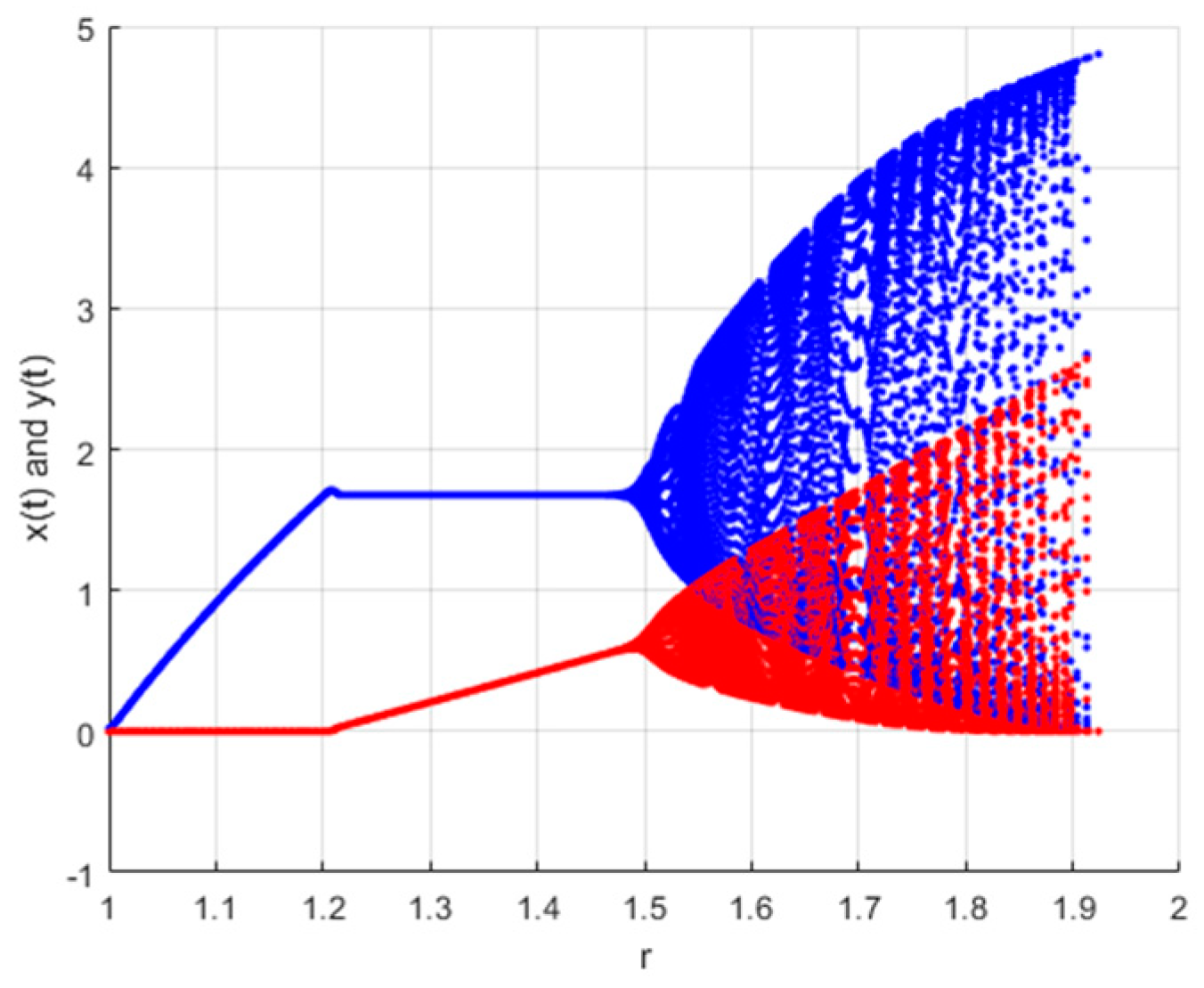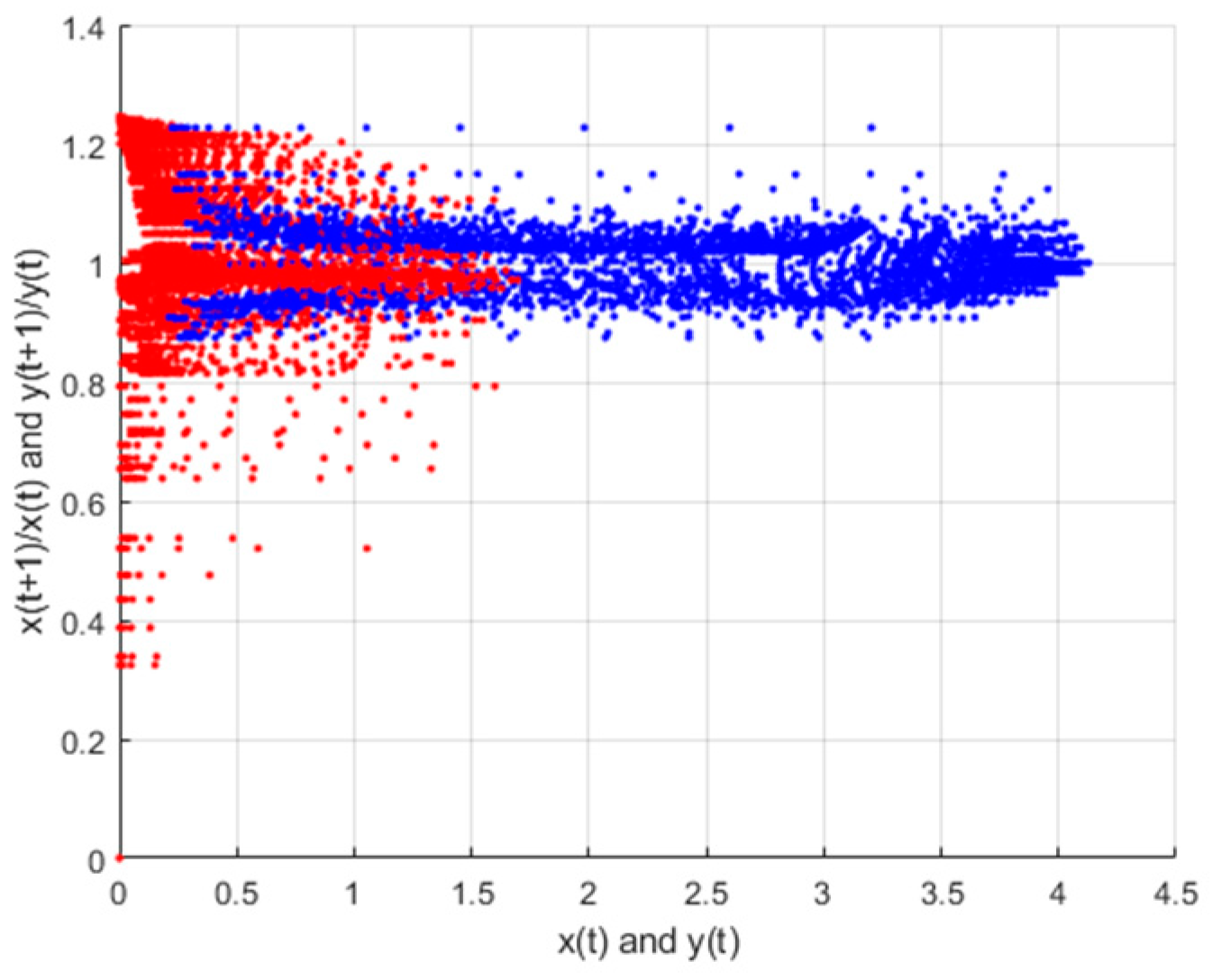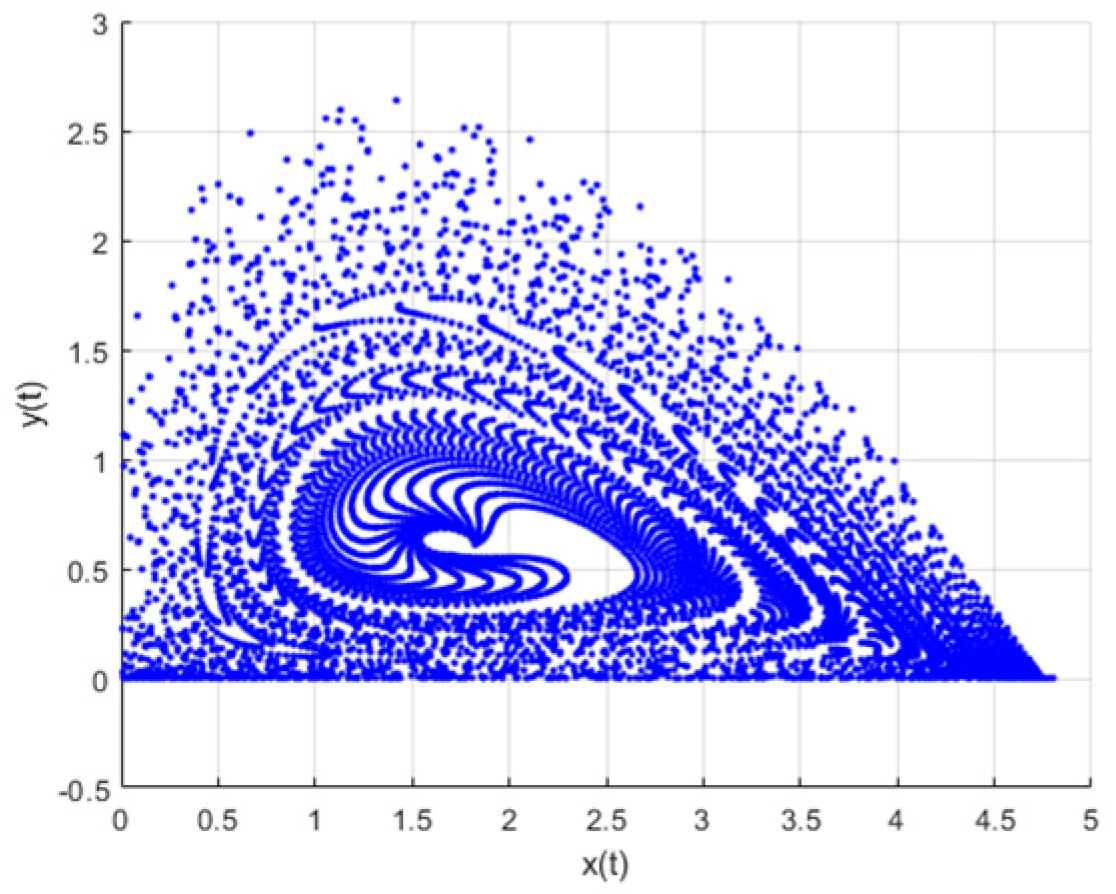Bifurcation and Stability Analysis of a System of Fractional-Order Differential Equations for a Plant–Herbivore Model with Allee Effect
Abstract
:1. Introduction
2. Stability Analysis
2.1. Equilibrium Points
2.2. Local Stability
- (i)
- For , if , then is locally asymptotically stable;
- (ii)
- For , if then is an unstable saddle point.
- (i)
- Assume that and , where . Ifthen we either attain real or complex conjugates roots with negative real parts, where > is equivalent to the Routh–Hurwitz case. Thus, is locally asymptotically stable;
- (ii)
- Assume that and , where . Ifthen we attain complex conjugates with positive real parts andwhich implies that is locally asymptotically stable.
- (i)
- Let us consider the case where . Fromwe havewhere Furthermore, computations show that, forwe obtain , where . In this case, we have .
- (ii)
- Let us consider the case, where . In this case, we havewhere
3. Existence and Uniqueness
- (i)
- , where
- (ii)
- satisfies Equation (27).
4. Analyzing the Plant–Herbivore Population at Low Density
- (i)
- Assume that and , where . Ifthen we either attain real roots or complex conjugates with negative real parts, where > is equivalent to the Routh–Hurwitz case, which means that is locally asymptotically stable;
- (ii)
- Assume that and , where . Ifthen both roots are complex conjugates with positive real parts andwhich implies that is locally asymptotically stable.
- (i)
- Let us consider the case where . Sincewe havewhere Furthermore, fromwe have , where . Thus, . Additionally, it is obvious that . This completes the proof of (i).
- (ii)
- Let us consider the case where . In this case, we havewhere Ifthen and , which implies that . This completes the proof of the theorem. □
5. Flip Bifurcation with Discretization Process
6. Conclusions
Author Contributions
Funding
Conflicts of Interest
References
- Abdelaziz, M.A.; Ismail, A.I.; Abdullah, F.A.; Mohd, M.H. Bifurcation and chaos in a discrete SI epidemic model with fractional order. Adv. Differ. Equ. 2018, 44, 1–19. [Google Scholar] [CrossRef]
- Mena-Lorca, J.; Hethcote, H.W. Dynamic models of infectious diseases regulators of population sizes. J. Math. Biol. 1992, 30, 693–716. [Google Scholar] [PubMed]
- Fend, Z.; Thieme, H.R. Recurrent outbreaks of childhood diseases revised: The impact of isolation. Math. Biosci. 1995, 32, 3–130. [Google Scholar]
- Liu, X.; Xiao, D. Complex dynamic behaviors of a discrete-time predator-prey system. Chaossolutions Fractals 2007, 32, 80–94. [Google Scholar] [CrossRef]
- Bozkurt, F. Stability analysis of a fractional order differential equation system of a GBM-IS interaction depending on the density. Appl. Math. Inf. Sci. 2014, 8, 1–8. [Google Scholar] [CrossRef]
- Kangalgil, F.; Kartal, S. Stability and bifurcation analysis in a host-parasitoid model with Hassell growth function. Adv. Differ. Equ. 2018, 240, 1–15. [Google Scholar] [CrossRef]
- Magin, R.; Ortigueira, M.D.; Podlubny, I.; Trujillo, J. On the fractional signal systems. Signal Process 2011, 91, 350–371. [Google Scholar] [CrossRef]
- Huang, C.; Cao, J.; Xiao, M.; Alsaedi, A.; Hayat, T. Bifurcations in a delayed fractional complex-valued neural network. Appl. Math. Comput. 2017, 292, 210–227. [Google Scholar] [CrossRef]
- Huang, C.; Cao, J.; Xiao, M.; Alsaedi, A.; Alsaadi, F.E. Controlling bifurcation in a delayed fractional predator-prey system with incommensurate orders. Appl. Math. Comput. 2017, 293, 293–310. [Google Scholar] [CrossRef]
- Huang, C.; Cao, J.; Xiao, M.; Alsaedi, A.; Hayat, T. Effects of time delays on stability and Hopf bifurcation in a fractional order ring-structured network with arbitrary neurons. Commun. Nonlinear Sci. Numer. Simul. 2018, 57, 1–13. [Google Scholar] [CrossRef]
- Youssef, I.K.; El Dewaik, M.H. Solving Poisson’s Equations with Fractional Order Using Haaravelet. Appl. Math. Nonlinear Sci. 2017, 2, 271–284. [Google Scholar] [CrossRef]
- Brzezinski, D.W. Comparison of fractional order derivatives computational accuracy-right hand vs left hand definition. Appl. Math. Nonlinear Sci. 2017, 2, 237–248. [Google Scholar] [CrossRef]
- Brzezinski, D.W. Review of numerical methods for NumILPT with computational accuracy assessment for fracional calculus. Appl. Math. Nonlinear Sci. 2018, 3, 487–502. [Google Scholar] [CrossRef]
- Al-Khaled, K.; Alquran, M. An approximate solution for a fractional order model of generalized Harry Dym equation. Math. Sci. 2014, 8, 125–130. [Google Scholar] [CrossRef]
- Bagley, R.L.; Calico, R.A. Fractional order state equations for the control of viscoelastically damped structures. J. Guid. Control Dyn. 1991, 14, 304–311. [Google Scholar] [CrossRef]
- Ichise, M.; Nagayanagi, Y.; Kojima, T. An analog simulation of non-integer order transfer functions for analysis of electrode process. J. Electroanal. Chem. Interfaction Electrochem. 1971, 33, 253–265. [Google Scholar] [CrossRef]
- Ahmad, W.M.; Sprott, J.C. Chaos in fractional order autonomous nonlinear systems. Chaos Solutions Fractals 2003, 16, 339–351. [Google Scholar] [CrossRef]
- Caughley, G.; Lawton, J.H. Plant-herbivore systems. In Theoretical Ecology; Principles and Applications; May, R.M., Ed.; Blackwell Scientific Publications: Blackwell, Oxford, UK, 1981; pp. 132–166. [Google Scholar]
- May, R.M. Stability and Complexity in Model Ecosystems; Princeton University Press: Princeton, NJ, USA, 2011. [Google Scholar]
- Kartal, S. Dynamics of a plant-herbivore model with differential-difference equations. Cogent Math. 2016, 3, 1–9. [Google Scholar] [CrossRef]
- Kang, Y.; Armbruster, D.; Kuang, Y. Dynamics of plant-herbivore model. J. Biol. Dyn. 2008, 2, 89–101. [Google Scholar] [CrossRef]
- Agiza, H.N.; Elabbasy, E.M.; El-Metwally, H.; Elsadany, A.A. Chaotic dynamics of a discrete prey-predator model with Hollingen type II. Nonlinear Anal. Real World Appl. 2009, 10, 116–129. [Google Scholar] [CrossRef]
- Chattopadhayay, J.; Sarkar, R.; Fritzsche-Hoballah, M.E.; Turlings, T.C.; Bersier, L.F. Parasitoids may determine plant fitness-A mathematical model based on experimental data. J. Theor. Biol. 2001, 212, 295–302. [Google Scholar] [CrossRef] [PubMed]
- Podlubny, I. Fractional Differential Equations; Academic Press: New York, NY, USA, 1999. [Google Scholar]
- Matignon, D. Stability results for fractional differential equations with applications to control processing. Proceeding of IMACS-IEE/SMC Conference on Computational Engineering in Systems Applications, Lille, Frace, 9–12 July 1996; 2, pp. 963–968. [Google Scholar]
- Allee, W.C. Animal Aggregations: A Study in General Sociology; University of Chicago Press: Chicago, IL, USA, 1931. [Google Scholar]
- Wang, G.; Liang, X.G.; Wang, F.Z. The competitive dynamics of populations subject to an Allee Effect. Ecol. Model. 1999, 124, 183–192. [Google Scholar] [CrossRef]
- Lande, R. Extinction threshold in demographic models of territorial. Am. Nat. 1987, 130, 624–635. [Google Scholar] [CrossRef]
- Dennis, B. Allee Effect: Population growth, critical density, and change of extinction. Nat. Resour. Model 1989, 3, 481–538. [Google Scholar] [CrossRef]
- Asmussen, M.A. Density-dependent selection II. The Allee Effect. Am. Naturalist 1979, 14, 796–809. [Google Scholar] [CrossRef]
- Bozkurt, F.; Abdeljawad, T.; Hajji, M.A. Stability analysis of a fractional order differential equation model of a brain tumor growth depending on the density. Appl. Comput. Math. 2015, 14, 1–13. [Google Scholar]
- Yuang, L.G.; Yang, Q.G. Bifurcation, invariant curve and hybrid control in a discrete-time predator-prey system. Appl. Math. Model. 2015, 39, 2345–2362. [Google Scholar] [CrossRef]






© 2019 by the authors. Licensee MDPI, Basel, Switzerland. This article is an open access article distributed under the terms and conditions of the Creative Commons Attribution (CC BY) license (http://creativecommons.org/licenses/by/4.0/).
Share and Cite
Yousef, A.; Yousef, F.B. Bifurcation and Stability Analysis of a System of Fractional-Order Differential Equations for a Plant–Herbivore Model with Allee Effect. Mathematics 2019, 7, 454. https://doi.org/10.3390/math7050454
Yousef A, Yousef FB. Bifurcation and Stability Analysis of a System of Fractional-Order Differential Equations for a Plant–Herbivore Model with Allee Effect. Mathematics. 2019; 7(5):454. https://doi.org/10.3390/math7050454
Chicago/Turabian StyleYousef, Ali, and Fatma Bozkurt Yousef. 2019. "Bifurcation and Stability Analysis of a System of Fractional-Order Differential Equations for a Plant–Herbivore Model with Allee Effect" Mathematics 7, no. 5: 454. https://doi.org/10.3390/math7050454




